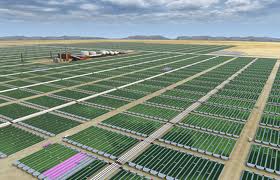According to current US legislation, biofuels will play a major role in our transportation future. By 2022, the Energy Independence and Security Act dictates that over 10 percent of our current petroleum consumption be replaced by biofuels, with over half that quantity coming from something other than corn. Although ethanol produced from the cellulose in plant waste and dedicated biofuels crops is already in use, many are looking further ahead at biofuels made from algae, which have some distinct advantages. Yesterday, some researchers at the Department of Energy released a study in which they describe a model that can help us determine just how much biofuel we might be able to squeeze out of algae.
At least for the first run, however, they used some pretty unrealistic starting points to just get a sense of how various assumptions influenced productivity. But the model produced some eye-popping numbers: if we maxed out algal productivity, we’d need to use several times the US’ annual irrigation water consumption to do so, but we could replace half of our current petroleum imports.
[ad]
As pointed out by the authors, algal biofuels have several distinct advantages. The microorganisms have a short life cycle and grow and reproduce rapidly, so their productivity is significantly higher than that of most crop- or vegetation-based biofuels. It’s also possible to harvest fats and lipids from them, which can be efficiently converted into biodiesel—the process requires less energy, and the fuel can be used in existing vehicles. Finally, algae have adapted to just about any water condition imaginable. We can choose species that will grow in saltwater, fresh water, agricultural runoff, municipal sewage—you name it.
That said, we’re still not sure about how best to grow them. For efficient growth, temperatures would need to be held within an optimal range (including during winter), and water evaporation and use in metabolism would require a constant supply. Closed systems can minimize these problems, but they have much higher energy and maintenance costs. Figuring out what future productivity could look like depends a lot on what assumptions you make regarding choices like siting, type of facility, etc.
The authors have created a model that lets some of those choices be tested. Their system can let a user select a specific type of land (flat land that is not in use for agriculture, for example) on which to locate a facility. Thirty years of weather records can be used to estimate how often the facility would need to heat the water the algae are growing in, how much sunlight would be available for growth, how fast water might evaporate from open ponds, and so on. Based on all of these parameters, the model can produce figures like water requirements and productivity.
It sounds like a very useful tool, but its output is necessarily going to be sensitive to various input parameters, which will ultimately mean that it can be used to produce radically different figures. For example, it’s easy to focus on the half of oil imports figure, which is an estimate of how much we can get from the model if we try to maximize production of algal biofuels. That figure, however, is derived from some very specific assumptions that are, in many ways, unrealistic.
Even for the more realistic scenarios, the list of caveats is pretty extensive: water and nutrients are unlimited, only evaporation is considered, only open ponds are used, and the authors ignore the energy demand involved in keeping the ponds from freezing or processing the algae into fuel. The authors also go exclusively with open ponds instead of closed systems. These are simpler to build, but have their own difficulties: they are harder to maintain at appropriate temperatures, they lose lots of water to evaporation, and they need to be built where it’s relatively flat.
By using the geographic data, the authors were able to find areas in the US that were appropriately flat, sparsely populated, and not currently being used for agriculture or protected as part of a park; that turned out to be over five percent of the continental US, largely in the Southeast, along the Great Lakes, and scattered throughout the West. The most productive areas were where the sun is brightest, in the desert southwest of Arizona, New Mexico, and West Texas. If all the appropriate land in the US were given over to biofuels, the weather would allow it to produce 220 Gigaliters/year, about half of our current oil imports. However, we have nothing like the freshwater needed to do that.
So the authors balance productivity against water requirements, and that rules out some of the most productive areas, given that evaporation in the desert is very high. In this analysis, the areas around the Great Lakes do well even though they aren’t very productive, since the cooler temperatures cut down on the evaporation; the Southeast’s Atlantic seaboard also does well due to high humidity. Given a reasonable water use cutoff, these areas could produce the equivalent to 17 percent of our current oil imports, while using only a quarter of our current irrigation water.
That’s still quite high, but remember that this assumes unpolluted freshwater. The areas along the Gulf and Atlantic cost could easily use a combination of saltwater and municipal waste. The latter source could potentially provide for facilities in some of the areas in the Southwest that are otherwise ruled out due to their high water use.
These latter points are, by the authors’ own admission, beyond the scope of the paper. The degree to which these approaches have a return on energy use will also be a critical factor to consider. But the authors actually indicate that they hope others will use their models to do more detailed analysis with alternate water sources and algal growth methods. Ideally, if they’re taken up on this offer, we’ll have a clearer picture of the potential of algal biofuels.
Thanks and Source arstechnica.com


